Hum Genet. 2006 Sep 28; [Epub ahead of print]
Elevated male European and female African contributions to the genomes of African American individuals.
Lind JM, Hutcheson-Dilks HB, Williams SM, Moore JH, Essex M, Ruiz-Pesini E, Wallace DC, Tishkoff SA, O'brien SJ, Smith MW.
The differential relative contribution of males and females from Africa and Europe to individual African American genomes is relevant to mapping genes utilizing admixture analysis. The assessment of ancestral population contributions to the four types of genomic DNA (autosomes, X and Y chromosomes, and mitochondrial) with their differing modes of inheritance is most easily addressed in males. A thorough evaluation of 93 African American males for 2,018 autosomal single nucleotide polymorphic (SNP) markers, 121 X chromosome SNPs, 10 Y chromosome haplogroups specified by SNPs, and six haplogroup defining mtDNA SNPs is presented. A distinct lack of correlation observed between the X chromosome and the autosomal admixture fractions supports separate treatment of these chromosomes in admixture-based gene mapping applications. The European genetic contributions were highest (and African lowest) for the Y chromosome (28.46%), followed by the autosomes (19.99%), then the X chromosome (12.11%), and the mtDNA (8.51%). The relative order of admixture fractions in the genomic compartments validates previous studies that suggested sex-biased gene flow with elevated European male and African female contributions. There is a threefold higher European male contribution compared with European females (Y chromosome vs. mtDNA) to the genomes of African American individuals meaning that admixture-based gene discovery will have the most power for the autosomes and will be more limited for X chromosome analysis.
Link
September 29, 2006
September 28, 2006
Stature of early Europeans
Hormones (Athens). 2003 Jul-Sep;2(3):175-8.
Stature of early Europeans
Hermanussen M.
The ancestors of modern Europeans arrived in Europe at least 40,000 years before present. Pre-glacial maximum Upper Palaeolithic males (before 16,000 BC) were tall and slim (mean height 179 cm, estimated average body weight 67 kg), while the females were comparably small and robust (mean height 158 cm, estimated average body weight 54 kg). Late Upper Palaeolithic males (8000-6600 BC) were of medium stature and robusticity (mean height 166 cm, estimated average body weight 62 kg). Stature further decreased to below 165 cm with estimated average body weight of 64 kg in Neolithic males of the Linear Band Pottery Culture, and to 150 cm with estimated average body weight of 49 kg in Neolithic females. The body stature of European males remained within the range of 165 to 170 cm up to the end of the 19(th) century.
Link
Stature of early Europeans
Hermanussen M.
The ancestors of modern Europeans arrived in Europe at least 40,000 years before present. Pre-glacial maximum Upper Palaeolithic males (before 16,000 BC) were tall and slim (mean height 179 cm, estimated average body weight 67 kg), while the females were comparably small and robust (mean height 158 cm, estimated average body weight 54 kg). Late Upper Palaeolithic males (8000-6600 BC) were of medium stature and robusticity (mean height 166 cm, estimated average body weight 62 kg). Stature further decreased to below 165 cm with estimated average body weight of 64 kg in Neolithic males of the Linear Band Pottery Culture, and to 150 cm with estimated average body weight of 49 kg in Neolithic females. The body stature of European males remained within the range of 165 to 170 cm up to the end of the 19(th) century.
Link
A new "article" suggests that using "race" is ok as long as it is used to meet the spiritual needs of indigenous people
According to these authors there are no biological "races", but nonetheless forensic anthropologists are not wrong to determine the "races" of individuals from skeletally distinctive populations in the interest of meeting their "spiritual needs". From the article:
Forensic Identification of "Race" The Issues in New Zealand
Katharine Cox, Nancy G. Tayles, and Hallie R. Buckley
The identification of the "race" of human remains by forensic anthropologists in New Zealand provides Maori with a service that is both helpful and contentious. In estimating "race" anthropologists acknowledge the Maori view that physical remains are important because they retain the spirit of the deceased after death. Doing so is ethically paradoxical because the estimation of "race" implies that races exist, a concept that has been questioned and rejected by most anthropologists. Despite this, to meet the needs of Maori and to treat human remains with the respect that is traditionally accorded them, forensic anthropologists have a responsibility to attempt to estimate "race."
Link
The reality in New Zealand is that many Maori and other Polynesians have distinctive characteristics that would permit identification of their ancestry from their skeletal remains. There is no justification for forensic anthropologists' refusing to attempt the identification of ancestry because of the abuse of human biological variation in the form of cultural racism. While not all Maori can be identified as such from their remains, because of the homogeneity of Maori and the distinctive morphology of many of them New Zealand may provide an opportunity for forensic anthropologists to meet the spiritual needs of the indigenous people without compromising their scientific principles.CURRENT ANTHROPOLOGY Volume 47, Number 5, October 2006
Forensic Identification of "Race" The Issues in New Zealand
Katharine Cox, Nancy G. Tayles, and Hallie R. Buckley
The identification of the "race" of human remains by forensic anthropologists in New Zealand provides Maori with a service that is both helpful and contentious. In estimating "race" anthropologists acknowledge the Maori view that physical remains are important because they retain the spirit of the deceased after death. Doing so is ethically paradoxical because the estimation of "race" implies that races exist, a concept that has been questioned and rejected by most anthropologists. Despite this, to meet the needs of Maori and to treat human remains with the respect that is traditionally accorded them, forensic anthropologists have a responsibility to attempt to estimate "race."
Link
Sociocultural Heterogeneity and the Commons
CURRENT ANTHROPOLOGY Volume 47, Number 5, October 2006
Sociocultural Heterogeneity and the Commons
Lore M. Ruttan
The effect of social and cultural heterogeneity on collective action and the management of natural resources is disputed. Some researchers have claimed that there are broadly negative effects, largely due to reduced levels of trust. Others have argued that there are specific positive effects; political entrepreneurs may appear who instigate collective action. Here, alternative predictions derived from these competing claims are tested against data on 40 fisheries and 54 irrigation cases contained in the Common-pool Resource Database. Results do not support the hypothesis that sociocultural heterogeneity is associated with positive outcomes, and in fact, among the irrigation cases, more entrepreneurial activity is observed when there is homogeneity. However, there is good support for the argument that trust is required for successful outcomes and that heterogeneity can limit levels of trust. In this respect, it is notable that differences in cultural view of the resource are salient in fisheries whereas differences in social categories matter in irrigation systems. Finally, the impact of heterogeneity depends heavily on how success is defined.
Link
Sociocultural Heterogeneity and the Commons
Lore M. Ruttan
The effect of social and cultural heterogeneity on collective action and the management of natural resources is disputed. Some researchers have claimed that there are broadly negative effects, largely due to reduced levels of trust. Others have argued that there are specific positive effects; political entrepreneurs may appear who instigate collective action. Here, alternative predictions derived from these competing claims are tested against data on 40 fisheries and 54 irrigation cases contained in the Common-pool Resource Database. Results do not support the hypothesis that sociocultural heterogeneity is associated with positive outcomes, and in fact, among the irrigation cases, more entrepreneurial activity is observed when there is homogeneity. However, there is good support for the argument that trust is required for successful outcomes and that heterogeneity can limit levels of trust. In this respect, it is notable that differences in cultural view of the resource are salient in fisheries whereas differences in social categories matter in irrigation systems. Finally, the impact of heterogeneity depends heavily on how success is defined.
Link
September 27, 2006
mtDNA of domestic yaks
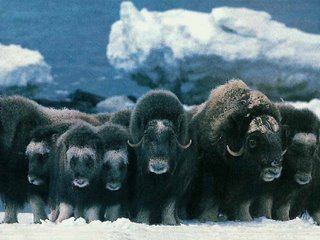
BMC Evol Biol. 2006 Sep 22;6(1):73 [Epub ahead of print]
Origin of mitochondrial DNA diversity of domestic yaks.
Guo S et al.
ABSTRACT: BACKGROUND: The domestication of plants and animals was extremely important anthropologically. Previous studies have revealed a general tendency for populations of livestock species to include deeply divergent maternal lineages, indicating that they were domesticated in multiple, independent events from genetically discrete wild populations. However, in water buffalo, there are suggestions that a similar deep maternal bifurcation may have originated from a single population. These hypotheses have rarely been rigorously tested because of a lack of sufficient wild samples. To investigate the origin of the domestic yak (Poephagus grunnies), we analyzed 637 bp of maternal inherited mtDNA from 13 wild yaks (including eight wild yaks from a small population in west Qinghai) and 250 domesticated yaks from major herding regions. RESULTS: The domestic yak populations had two deeply divergent phylogenetic groups with a divergence time of > 100,000 yrs BP. We here show that haplotypes clustering with two deeply divergent maternal lineages in domesticated yaks occur in a single, small, wild population. This finding suggests that all domestic yaks are derived from a single wild gene pool. However, there is no clear correlation of the mtDNA phylogenetic clades and the 10 morphological types of sampled yaks indicating that the latter diversified recently. Relatively high diversity was found in Qinghai and Tibet around the current wild distribution, in accordance with previous suggestions that the earliest domestications occurred in this region. Conventional molecular clock estimation led to an unrealistic early dating of the start of the domestication. However, Bayesian estimation of the coalescence time allowing a relaxation of the mutation rate are better in agreement with a domestication during the Holocene as supported by archeological records. CONCLUSION: The information gathered here and the previous studies of other animals show that the demographic histories of domestication of livestock species were highly diverse despite the common general feature of deeply divergent maternal lineages. The results further suggest that domestication of local wild prey ungulate animals was a common occurrence during the development of human civilization following the postglacial colonization in different locations of the world, including the high, arid Qinghai-Tibetan Plateau.
Link
September 26, 2006
Naturalism, final causes, religion, and atheism
Naturalism can be defined in many different ways, but a useful one is that it represents the idea that things happen because of natural causes and not for any particular purpose.
A naturalistic explanation about life on earth, for example, is that it is the product of natural causes, i.e., chemical molecules attaining the ability to replicate, and then evolving by modification and selection. And, of course, this explanation is true.
Acceptance of naturalism does not, however, imply atheism, as some prominent atheists seem to believe. The argument seems to be that if things are perfectly explained by natural causes, then there is no room for god: the assumption of the existence of god, is not necessary.
A commonly used argument against this explanation is that of natural exceptionalism. This argument goes like this: the world can be explained naturalistically, but the deity can bend the rules and suspend their operation, operating miraculously.
This argument is not very persuasive, since it requires that one should document the existence of miracles, and miracles are notoriously difficult to document to a skeptic's satisfaction, and rightly so.
However, miracles (*) are not necessary to support a theist's belief in god.
We can think of a digital computer whose operation is perfectly predictable: its state at any point in time is precisely determined from its state at previous points in time. The computer's operation can be precisely determined by the digital logic of its circuits, the oscillation of its clock, and the contents of its memory. It is thus a perfectly naturalistic system, whose operation is precisely determined by natural causes.
Nonetheless, computers typically compute "something". At short time scales, a scientist examining the computer would be able to discover some natural "laws" governing its operation, say, that when a particular instruction is read from memory, the content of two memory locations is added and placed in a third one. A whole repertoire of such laws could be determined, and the scientist could predict the computer's operation exactly. Nonetheless, this would give him no knowledge about what the computer was actually doing, what the purpose of the computation was.
The naturalist is content with determining the "laws of nature". But, the laws of nature are simply the allowed moves in the "game of reality", they are the instruction set of the universe. Knowing them tells us nothing about whether or not the unravelling computation has a final cause or not, whether it aims to compute something or not.
From this perspective, the atheist resembles a chess spectator who is able, by observation, to determine the rules of chess, e.g., that bishops move diagonally and rooks along straight lines, but claims that the game has no inherent purpose. The theist on the other hand believes that the sequence of legal moves are not meaningless, but rather aim towards a goal, which is victory. (**)
It seems to me that the theist has a much better ground to stand on than the atheist. Even though we are unable to determine the goal of the universe's evolution (if any), we can still observe it, and draw some tentative conclusions.
There are 2n n-bit long programs, for example, yet only a tiny fraction of them compute anything meaningful. You could fill up your computer's memory with random junk, and it would still work by following the random instructions. Our observation of the universe looks nothing like a random program however; it looks more like an orderly and well-behaved program, so, in my opinion, the idea that it has a purpose is more defensible than the idea that it does not.(***)
(*) It should be noted that the idea of a miracle as a suspension of natural law is modern, dating to the post-Newtonian period and the worldview of the world-as-a-clock. In the original sense, miracles (Gk. θαύματα) are extra-ordinary phenomena that cause a sense of wonder (θαυμάζειν) and are not "supernatural" events, but rather rare events, outliers.
(**) Chess is actually a great example of this, since the game itself is finite and can be computed. Of course, the number of possible chess games is finite, although very large, but in principle, a superfast computer could determine whether an optimally played chess of game will lead to a white victory or a draw, even though we have no idea what the answer will be. But, our inability (as humans) to compute the answer to "chess" does not mean that it does not have a clear (albeit exceedingly difficult) solution.
(***) Atheists often use an anthropic argument against this observation; they claim that all possible sets of laws are operating, and we are lucky enough to be in a region where the laws tend to allow for intelligence. This argument is not very persuasive though, since it postulates an infinite number of non-observable realities. Moreover, intelligence could very well have evolved in a tiny patch of order of an otherwise chaotic universe; it would not make one iota of difference for life on earth if, e.g., gravity operated differently in galaxies billions of light years away. The fact that not only our small patch of reality that is the solar system, but the entire observable universe is orderly is a pretty good argument against anthropic explanations.
A naturalistic explanation about life on earth, for example, is that it is the product of natural causes, i.e., chemical molecules attaining the ability to replicate, and then evolving by modification and selection. And, of course, this explanation is true.
Acceptance of naturalism does not, however, imply atheism, as some prominent atheists seem to believe. The argument seems to be that if things are perfectly explained by natural causes, then there is no room for god: the assumption of the existence of god, is not necessary.
A commonly used argument against this explanation is that of natural exceptionalism. This argument goes like this: the world can be explained naturalistically, but the deity can bend the rules and suspend their operation, operating miraculously.
This argument is not very persuasive, since it requires that one should document the existence of miracles, and miracles are notoriously difficult to document to a skeptic's satisfaction, and rightly so.
However, miracles (*) are not necessary to support a theist's belief in god.
We can think of a digital computer whose operation is perfectly predictable: its state at any point in time is precisely determined from its state at previous points in time. The computer's operation can be precisely determined by the digital logic of its circuits, the oscillation of its clock, and the contents of its memory. It is thus a perfectly naturalistic system, whose operation is precisely determined by natural causes.
Nonetheless, computers typically compute "something". At short time scales, a scientist examining the computer would be able to discover some natural "laws" governing its operation, say, that when a particular instruction is read from memory, the content of two memory locations is added and placed in a third one. A whole repertoire of such laws could be determined, and the scientist could predict the computer's operation exactly. Nonetheless, this would give him no knowledge about what the computer was actually doing, what the purpose of the computation was.
The naturalist is content with determining the "laws of nature". But, the laws of nature are simply the allowed moves in the "game of reality", they are the instruction set of the universe. Knowing them tells us nothing about whether or not the unravelling computation has a final cause or not, whether it aims to compute something or not.
From this perspective, the atheist resembles a chess spectator who is able, by observation, to determine the rules of chess, e.g., that bishops move diagonally and rooks along straight lines, but claims that the game has no inherent purpose. The theist on the other hand believes that the sequence of legal moves are not meaningless, but rather aim towards a goal, which is victory. (**)
It seems to me that the theist has a much better ground to stand on than the atheist. Even though we are unable to determine the goal of the universe's evolution (if any), we can still observe it, and draw some tentative conclusions.
There are 2n n-bit long programs, for example, yet only a tiny fraction of them compute anything meaningful. You could fill up your computer's memory with random junk, and it would still work by following the random instructions. Our observation of the universe looks nothing like a random program however; it looks more like an orderly and well-behaved program, so, in my opinion, the idea that it has a purpose is more defensible than the idea that it does not.(***)
(*) It should be noted that the idea of a miracle as a suspension of natural law is modern, dating to the post-Newtonian period and the worldview of the world-as-a-clock. In the original sense, miracles (Gk. θαύματα) are extra-ordinary phenomena that cause a sense of wonder (θαυμάζειν) and are not "supernatural" events, but rather rare events, outliers.
(**) Chess is actually a great example of this, since the game itself is finite and can be computed. Of course, the number of possible chess games is finite, although very large, but in principle, a superfast computer could determine whether an optimally played chess of game will lead to a white victory or a draw, even though we have no idea what the answer will be. But, our inability (as humans) to compute the answer to "chess" does not mean that it does not have a clear (albeit exceedingly difficult) solution.
(***) Atheists often use an anthropic argument against this observation; they claim that all possible sets of laws are operating, and we are lucky enough to be in a region where the laws tend to allow for intelligence. This argument is not very persuasive though, since it postulates an infinite number of non-observable realities. Moreover, intelligence could very well have evolved in a tiny patch of order of an otherwise chaotic universe; it would not make one iota of difference for life on earth if, e.g., gravity operated differently in galaxies billions of light years away. The fact that not only our small patch of reality that is the solar system, but the entire observable universe is orderly is a pretty good argument against anthropic explanations.
Decorated skulls in Syria
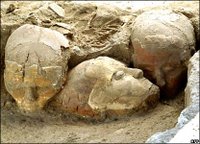 Decorated skulls have been found in Syria. The picture on the left is from the BBC. AFP reports:
Decorated skulls have been found in Syria. The picture on the left is from the BBC. AFP reports:DAMASCUS (AFP) - Archaeologists said they had uncovered decorated human skulls dating back as long as 9,500 years ago from a burial site near the Syrian capital Damascus.
"The human skulls date back between 9,500 and 9,000 years ago, (on which) lifelike faces were modelled with clay earth ... then coloured to accentuate the features," said Danielle Stordeur, head of the joint French-Syrian archaeological mission behind the discovery.
Located at a burial site near a prehistoric village, the five skulls were found earlier this month in a pit resting against one another, underneath the remains of an infant, said Stordeur.
The French archaeologist described as "extraordinary" the find at the Neolithic site of Tell Aswad, at Jaidet al-Khass village, 35 kilometres (22 miles) from Damascus.
The discovery was not the first of its kind in the Middle East, but "the realism of two of these skulls is striking," stressed Stordeur, in charge of the excavation along with Bassam Jamous, the chief of antiquities of Syria's National Museum.
"They surprise by the regularity and the smoothness of their features," Stordeur said of the skulls.
"The eyes are shown as closed, underlined by black bitumen. The nose is straight and fine, with a pinched base to portray the nostrils.
"The mouth is reduced to a slit," said Stordeur, of the Asian research house of the National Centre for Scientific Research (CNRS), France's largest scientific establishment.
The decorated skulls were devoted "only to important individuals, chosen according to social or religious criteria," she added.
September 23, 2006
mtDNA haplogroup M in prehistoric North Americans
One more for the Ancient DNA compendium:
Journal of Archaeological Science (Article in Press)
Mitochondrial haplogroup M discovered in prehistoric North Americans
Ripan S. Malhi et al.
Abstract
We analyzed two mid-Holocene (not, vert, similar5000 years before present) individuals from North America that belong to mitochondrial DNA (mtDNA) haplogroup M, a common type found in East Asia, but one that has never before been reported in ancient or living indigenous populations in the Americas. This study provides evidence that the founding migrants of the Americas exhibited greater genetic diversity than previously recognized, prompting us to reconsider the widely accepted five-founder model that posits that the Americas were colonized by only five founding mtDNA lineages. Additional genetic studies of prehistoric remains in the Americas are likely to reveal important insights into the early population history of Native Americans. However, the usefulness of this information will be tempered by the ability of researchers to distinguish novel founding lineages from contamination and, as such, we recommend strategies to successfully accomplish this goal.
Link
Journal of Archaeological Science (Article in Press)
Mitochondrial haplogroup M discovered in prehistoric North Americans
Ripan S. Malhi et al.
Abstract
We analyzed two mid-Holocene (not, vert, similar5000 years before present) individuals from North America that belong to mitochondrial DNA (mtDNA) haplogroup M, a common type found in East Asia, but one that has never before been reported in ancient or living indigenous populations in the Americas. This study provides evidence that the founding migrants of the Americas exhibited greater genetic diversity than previously recognized, prompting us to reconsider the widely accepted five-founder model that posits that the Americas were colonized by only five founding mtDNA lineages. Additional genetic studies of prehistoric remains in the Americas are likely to reveal important insights into the early population history of Native Americans. However, the usefulness of this information will be tempered by the ability of researchers to distinguish novel founding lineages from contamination and, as such, we recommend strategies to successfully accomplish this goal.
Link
So, what did Muhammed bring that was not evil and inhuman?
"Show me just what Mohammed brought that was new, and there you will find things only evil and inhuman, such as his command to spread by the sword the faith he preached." - Manuel II
I am interested in hearing the opinion of Muslims and non-Muslims alike. I can't think of a single element of the Muslim religion that wasn't (i) already established or preached by previous religions, (ii) a religiously unimportant convention, or (iii) evil and inhuman.
An example of category (i) is e.g., monotheism, which is an integral part of Judaism.
An example of category (ii) is praying towards Mecca.
An example of category (iii) is Muhammad's commandment to slay the unbelievers.
So, what Islamic innovation isn't covered by (i-iii) but belongs in a category (iv) of good and positive innovations brought by Muhammed?
I am interested in hearing the opinion of Muslims and non-Muslims alike. I can't think of a single element of the Muslim religion that wasn't (i) already established or preached by previous religions, (ii) a religiously unimportant convention, or (iii) evil and inhuman.
An example of category (i) is e.g., monotheism, which is an integral part of Judaism.
An example of category (ii) is praying towards Mecca.
An example of category (iii) is Muhammad's commandment to slay the unbelievers.
So, what Islamic innovation isn't covered by (i-iii) but belongs in a category (iv) of good and positive innovations brought by Muhammed?
Oppenheimer on British Origins
I have glanced through many popular books on human population genetics (HPG), and I find most of them to be worthless. Unlike physics or other established sciences, where popularizers work against the background of well-established theories, HPG popularizers are working with a field that is fairly new, and where many theories are fiercely debated. As a result, they run the constant risk of either presenting elaborate theories that are demolished by newer findings, reading more to the evidence than is warranted by the facts, or dumbing down the material to such a degree, that anyone with even a superficial knowledge of the field loses all interest.
I had enjoyed reading Stephen Oppenheimer's previous book The Real Eve; even though I disagreed with many of the things written in it, at least it was a thoughtful and informative read, which really tried to interpret and present the best available evidence. Even though Oppenheimer is not a professional geneticist, his book was more thoughtful and "deep" than most of the high-profile figures of the field.
Oppenheimer has a new book out about the origins of the British, and a new article in Prospect magazine:
I have mostly accepted the traditional theory of Central European origins of the Celts, even though I know (or care) very little about that subject. I am not sure how Oppenheimer derives them from Southwest Europe, but that idea makes some excellent sense. After all, the Celts were first identified by classical writers in Southwestern, not Central Europe, and that is where their languages survived to this day.
The idea that the Celts were drawn from the same dispersal out of the southeast into southwest Europe is also attractive because it explains readily the commonalities between Celtic and Italic languages; it also harmonizes with the relative lack of DNA "signals" that would link the inhabitants of Western Europe with those of Central Europe. It fits quite well into the emerging picture of Indo-European dispersals out of Southeastern Europe, with Italo-Celts being responsible for maritime pioneer colonization across the northern Mediterranean, Germanics being responsible for northward movements from Central European descendants of the Linearbandkeramik, and Balto-Slavs derived from northeastern movements of the Bronze Age which brought Corded Ware type people into contact with the Finno-Ugric substratum of eastern Europe.
Oppenheimer also addresses the idea of an Anglo-Saxon imposed apartheid in Britain:
I like the idea that England was not mainly Celtic speaking before the invasion of Anglo-Saxons. For one thing, the native inhabitants of the British Isles were not identified as Celts by the ancient writers; this is puzzling if they were kinsmen of the continental Celts. The existence of Celts in the British Isles is of course proven on linguistic grounds, but their dominance is very speculative. It is probably due to the fact that the Celts are the only identifiable non-Germanic inhabitants of the Isles who have left a linguistic and cultural legacy (to some extent), so pre-Anglo-Saxons are assumed -wrongly- to have been Celtic.
I had enjoyed reading Stephen Oppenheimer's previous book The Real Eve; even though I disagreed with many of the things written in it, at least it was a thoughtful and informative read, which really tried to interpret and present the best available evidence. Even though Oppenheimer is not a professional geneticist, his book was more thoughtful and "deep" than most of the high-profile figures of the field.
Oppenheimer has a new book out about the origins of the British, and a new article in Prospect magazine:
Given the distribution of Celtic languages in southwest Europe, it is most likely that they were spread by a wave of agriculturalists who dispersed 7,000 years ago from Anatolia, travelling along the north coast of the Mediterranean to Italy, France, Spain and then up the Atlantic coast to the British Isles. There is a dated archaeological trail for this. My genetic analysis shows exact counterparts for this trail both in the male Y chromosome and the maternally transmitted mitochondrial DNA right up to Cornwall, Wales, Ireland and the English south coast.
Further evidence for the Mediterranean origins of Celtic invaders is preserved in medieval Gaelic literature. According to the orthodox academic view of "iron-age Celtic invasions" from central Europe, Celtic cultural history should start in the British Isles no earlier than 300 BC. Yet Irish legend tells us that all six of the cycles of invasion came from the Mediterranean via Spain, during the late Neolithic to bronze age, and were completed 3,700 years ago.
I have mostly accepted the traditional theory of Central European origins of the Celts, even though I know (or care) very little about that subject. I am not sure how Oppenheimer derives them from Southwest Europe, but that idea makes some excellent sense. After all, the Celts were first identified by classical writers in Southwestern, not Central Europe, and that is where their languages survived to this day.
The idea that the Celts were drawn from the same dispersal out of the southeast into southwest Europe is also attractive because it explains readily the commonalities between Celtic and Italic languages; it also harmonizes with the relative lack of DNA "signals" that would link the inhabitants of Western Europe with those of Central Europe. It fits quite well into the emerging picture of Indo-European dispersals out of Southeastern Europe, with Italo-Celts being responsible for maritime pioneer colonization across the northern Mediterranean, Germanics being responsible for northward movements from Central European descendants of the Linearbandkeramik, and Balto-Slavs derived from northeastern movements of the Bronze Age which brought Corded Ware type people into contact with the Finno-Ugric substratum of eastern Europe.
Oppenheimer also addresses the idea of an Anglo-Saxon imposed apartheid in Britain:
Some geneticists still cling to the genocide story. Research by several genetics teams associated with University College London has concentrated in recent years on proving the wipeout view on the basis of similarities of male Y chromosome gene group frequency between Frisia/north Germany and England. One of the London groups attracted press attention in July by claiming that the close similarities were the result of genocide followed by a social-sexual apartheid that enhanced Anglo-Saxon reproductive success over Celtic.
The problem is that the English resemble in this way all the other countries of northwest Europe as well as the Frisians and Germans. Using the same method (principal components analysis, see note below), I have found greater similarities of this kind between the southern English and Belgians than the supposedly Anglo-Saxon homelands at the base of the Danish peninsula. These different regions could not all have been waiting their turn to commit genocide on the former Celtic population of England. The most likely reason for the genetic similarities between these neighbouring countries and England is that they all had similar prehistoric settlement histories.
...
The orthodox view is that the entire population of the British Isles, including England, was Celtic-speaking when Caesar invaded. But if that were the case, a modest Anglo-Saxon invasion is unlikely to have swept away all traces of Celtic language from the pre-existing population of England. Yet there are only half a dozen Celtic words in English, the rest being mainly Germanic, Norman or medieval Latin. One explanation is that England was not mainly Celtic-speaking before the Anglo-Saxons. Consider, for example, the near-total absence of Celtic inscriptions in England (outside Cornwall), although they are abundant in Ireland, Wales, Scotland and Brittany.
I like the idea that England was not mainly Celtic speaking before the invasion of Anglo-Saxons. For one thing, the native inhabitants of the British Isles were not identified as Celts by the ancient writers; this is puzzling if they were kinsmen of the continental Celts. The existence of Celts in the British Isles is of course proven on linguistic grounds, but their dominance is very speculative. It is probably due to the fact that the Celts are the only identifiable non-Germanic inhabitants of the Isles who have left a linguistic and cultural legacy (to some extent), so pre-Anglo-Saxons are assumed -wrongly- to have been Celtic.
September 21, 2006
Human pigmentation genes in Africans, Europeans, and Chinese
Mark Stoneking and co-authors from the Max Planck Institute for Evolutionary Anthropology have a new paper on human pigmentation genes in Human Genetics. From the paper:
These results probably suggest that early Eurasians were dark, and evolved their light skin pigmentation separately, with different genes contributing to the depigmentation of Caucasoids and Mongoloids.
Human Genetics (online first)
Identifying genes underlying skin pigmentation differences among human populations
Sean Myles et al.
Skin pigmentation is a human phenotype that varies greatly among human populations and it has long been speculated that this variation is adaptive. We therefore expect the genes that contribute to these large differences in phenotype to show large allele frequency differences among populations and to possibly harbor signatures of positive selection. To identify the loci that likely contribute to among-population human skin pigmentation differences, we measured allele frequency differentiation among Europeans, Chinese and Africans for 24 human pigmentation genes from 2 publicly available, large scale SNP data sets. Several skin pigmentation genes show unusually large allele frequency differences among these populations. To determine whether these allele frequency differences might be due to selection, we employed a within-population test based on long-range haplotype structure and identified several outliers that have not been previously identified as putatively adaptive. Most notably, we identify the DCT gene as a candidate for recent positive selection in the Chinese. Moreover, our analyses suggest that it is likely that different genes are responsible for the lighter skin pigmentation found in different non-African populations.
Link
It is notable that no gene shows a shared signature of selection in Europeans and Chinese, relative to Africans. These results suggest that the lighter skin pigmentation observed in non-African populations is the result of positive selection on different loci in different human populations. The identification and analysis of additional genes involved in human skin pigmentation and the functional characterization of the allelic variants at the candidate loci presented here will help clarify the nature and extent of skin pigmentation adaptation in human populations.
These results probably suggest that early Eurasians were dark, and evolved their light skin pigmentation separately, with different genes contributing to the depigmentation of Caucasoids and Mongoloids.
Human Genetics (online first)
Identifying genes underlying skin pigmentation differences among human populations
Sean Myles et al.
Skin pigmentation is a human phenotype that varies greatly among human populations and it has long been speculated that this variation is adaptive. We therefore expect the genes that contribute to these large differences in phenotype to show large allele frequency differences among populations and to possibly harbor signatures of positive selection. To identify the loci that likely contribute to among-population human skin pigmentation differences, we measured allele frequency differentiation among Europeans, Chinese and Africans for 24 human pigmentation genes from 2 publicly available, large scale SNP data sets. Several skin pigmentation genes show unusually large allele frequency differences among these populations. To determine whether these allele frequency differences might be due to selection, we employed a within-population test based on long-range haplotype structure and identified several outliers that have not been previously identified as putatively adaptive. Most notably, we identify the DCT gene as a candidate for recent positive selection in the Chinese. Moreover, our analyses suggest that it is likely that different genes are responsible for the lighter skin pigmentation found in different non-African populations.
Link
September 20, 2006
Ethnogenesis of indigenous Southeast Asians
See also 25,800-year old Australoid from Thailand and Coastal Migration Theory.
Mol Biol Evol. 2006 Sep 18; [Epub ahead of print]
Phylogeography and Ethnogenesis of Aboriginal Southeast Asians.
Hill C, Soares P, Mormina M, Macaulay V, Meehan W, Blackburn J, Clarke D, Raja JM, Ismail P, Bulbeck D, Oppenheimer S, Richards M.
Studying the genetic history of the Orang Asli of Peninsular Malaysia can provide crucial clues to the peopling of Southeast Asia as a whole. We have analyzed mitochondrial DNA control-region and coding-region markers in 447 mitochondrial DNAs (mtDNAs) from the region, including 260 Orang Asli, representative of each of the traditional groupings, the Semang, the Senoi and the Aboriginal Malays, allowing us to test hypotheses about their origins. All of the Orang Asli groups have undergone high levels of genetic drift, but phylogeographic traces nevertheless remain of the ancestry of their maternal lineages. The Semang have a deep ancestry within the Malay Peninsula, dating to the initial settlement from Africa >50,000 years ago. The Senoi appear to be a composite group, with approximately half of the maternal lineages tracing back to the ancestors of the Semang, and about half to Indochina. This is in agreement with the suggestion that they represent the descendants of early Austroasiatic speaking agriculturalists, who brought both their language and their technology to the southern part of the peninsula approximately 4000 years ago, and coalesced with the indigenous population. The Aboriginal Malays are more diverse, and although they show some connections with island Southeast Asia, as expected, they also harbor haplogroups that are either novel or rare elsewhere. Contrary to expectations, complete mtDNA genome sequences from one of these, R9b, suggest an ancestry in Indochina around the time of the Last Glacial Maximum, followed by an early-Holocene dispersal through the Malay Peninsula into island Southeast Asia.
Link
Mol Biol Evol. 2006 Sep 18; [Epub ahead of print]
Phylogeography and Ethnogenesis of Aboriginal Southeast Asians.
Hill C, Soares P, Mormina M, Macaulay V, Meehan W, Blackburn J, Clarke D, Raja JM, Ismail P, Bulbeck D, Oppenheimer S, Richards M.
Studying the genetic history of the Orang Asli of Peninsular Malaysia can provide crucial clues to the peopling of Southeast Asia as a whole. We have analyzed mitochondrial DNA control-region and coding-region markers in 447 mitochondrial DNAs (mtDNAs) from the region, including 260 Orang Asli, representative of each of the traditional groupings, the Semang, the Senoi and the Aboriginal Malays, allowing us to test hypotheses about their origins. All of the Orang Asli groups have undergone high levels of genetic drift, but phylogeographic traces nevertheless remain of the ancestry of their maternal lineages. The Semang have a deep ancestry within the Malay Peninsula, dating to the initial settlement from Africa >50,000 years ago. The Senoi appear to be a composite group, with approximately half of the maternal lineages tracing back to the ancestors of the Semang, and about half to Indochina. This is in agreement with the suggestion that they represent the descendants of early Austroasiatic speaking agriculturalists, who brought both their language and their technology to the southern part of the peninsula approximately 4000 years ago, and coalesced with the indigenous population. The Aboriginal Malays are more diverse, and although they show some connections with island Southeast Asia, as expected, they also harbor haplogroups that are either novel or rare elsewhere. Contrary to expectations, complete mtDNA genome sequences from one of these, R9b, suggest an ancestry in Indochina around the time of the Last Glacial Maximum, followed by an early-Holocene dispersal through the Malay Peninsula into island Southeast Asia.
Link
Haplogroup Z in the Saami
From the article:
European Journal of Human Genetics advance online publication 20 September 2006; doi: 10.1038/sj.ejhg.5201712
A recent genetic link between Sami and the Volga-Ural region of Russia
Max Ingman and Ulf Gyllensten
Abstract
The genetic origin of the Sami is enigmatic and contributions from Continental Europe, Eastern Europe and Asia have been proposed. To address the evolutionary history of northern and southern Swedish Sami, we have studied their mtDNA haplogroup frequencies and complete mtDNA genome sequences. While the majority of mtDNA diversity in the northern Swedish, Norwegian and Finnish Sami is accounted for by haplogroups V and U5b1b1, the southern Swedish Sami have other haplogroups and a frequency distribution similar to that of the Continental European population. Stratification of the southern Sami on the basis of occupation indicates that this is the result of recent admixture with the Swedish population. The divergence time for the Sami haplogroup V sequences is 7600 YBP (years before present), and for U5b1b1, 5500 YBP amongst Sami and 6600 YBP amongst Sami and Finns. This suggests an arrival in the region soon after the retreat of the glacial ice, either by way of Continental Europe and/or the Volga-Ural region. Haplogroup Z is found at low frequency in the Sami and Northern Asian populations but is virtually absent in Europe. Several conserved substitutions group the Sami Z lineages strongly with those from Finland and the Volga-Ural region of Russia, but distinguish them from Northeast Asian representatives. This suggests that some Sami lineages shared a common ancestor with lineages from the Volga-Ural region as recently as 2700 years ago, indicative of a more recent contribution of people from the Volga-Ural region to the Sami population.
Link
The presence of haplogroup Z implies a contribution, albeit limited, to the Sami gene pool from Asia. The close relationship of Z1a lineages from Finns and Sami with those of the Volga-Ural again implicates that region as a probable source for Sami mitochondrial diversity. There is, however, a difference in the apparent ages of the different Sami haplogroups. The nucleotide diversity among Sami sequences for the three haplogroups studied here is very low. The ages of the variation for U5b1b1 and V among Swedish Sami are similar (5500 and 7600 YBP, respectively) but considerably older than for Z (2700 YBP). The surprisingly close link between haplogroup Z1a among Sami and the Volga-Ural sequences suggest that this haplogroup was brought in during the last 2–3000 YBP. Our data supports that a migration from Eastern Europe, in the vicinity of the Volga-Ural region, is the likely source for much of the Sami mtDNA diversity14 but indicates multiple migrations, the first being 6–7000 YBP and at least one additional migration 2–3000 YBP. Considering the similarity observed between Sami and Finnish mitochondrial lineages, this observation of multiple migration events would also support previous population genetic studies that have indicated dual origins of the Finnish people.37
European Journal of Human Genetics advance online publication 20 September 2006; doi: 10.1038/sj.ejhg.5201712
A recent genetic link between Sami and the Volga-Ural region of Russia
Max Ingman and Ulf Gyllensten
Abstract
The genetic origin of the Sami is enigmatic and contributions from Continental Europe, Eastern Europe and Asia have been proposed. To address the evolutionary history of northern and southern Swedish Sami, we have studied their mtDNA haplogroup frequencies and complete mtDNA genome sequences. While the majority of mtDNA diversity in the northern Swedish, Norwegian and Finnish Sami is accounted for by haplogroups V and U5b1b1, the southern Swedish Sami have other haplogroups and a frequency distribution similar to that of the Continental European population. Stratification of the southern Sami on the basis of occupation indicates that this is the result of recent admixture with the Swedish population. The divergence time for the Sami haplogroup V sequences is 7600 YBP (years before present), and for U5b1b1, 5500 YBP amongst Sami and 6600 YBP amongst Sami and Finns. This suggests an arrival in the region soon after the retreat of the glacial ice, either by way of Continental Europe and/or the Volga-Ural region. Haplogroup Z is found at low frequency in the Sami and Northern Asian populations but is virtually absent in Europe. Several conserved substitutions group the Sami Z lineages strongly with those from Finland and the Volga-Ural region of Russia, but distinguish them from Northeast Asian representatives. This suggests that some Sami lineages shared a common ancestor with lineages from the Volga-Ural region as recently as 2700 years ago, indicative of a more recent contribution of people from the Volga-Ural region to the Sami population.
Link
The Legal Consequences of Apostasy in Islam
September 19, 2006
Reported sexual orientation doesn't match with sexual behavior
From EurekAlert:
PHILADELPHIA, September 19, 2006 – A survey of 4,193 men living in New York City conducted by the New York City Department of Health and Mental Hygiene found that nearly 10 percent of male participants who identified themselves as straight reported having sex with at least one man during the previous year.
...
Compared to men who identified themselves as gay, these men were more likely to belong to a minority racial or ethnic group, be foreign-born, have a lower educational level, and live outside Manhattan. Seventy percent reported being married. This group also was less likely to have been tested for HIV infection during the previous year and less likely to have used a condom during the last sexual encounter than men who identified themselves as gay.
September 18, 2006
More massaged data from Richard Lynn
I had previously pointed out that Richard Lynn has massaged his data based on one study that I had access to and could thus cross-check his against Lynn's reported values. In a review (http://dx.doi.org/10.1016/j.intell.2006.08.001) of Race differences in intelligence: An evolutionary hypothesis in Intelligence, N.J. Mackintosh brings up more falsifications of data by Lynn:
More from the review:
Even if we wanted the data, can we rely on Lynn to have given an accurate account of them? I do not pretend to have read the originals of more than a handful of the papers and books cited by Lynn, but it just so happens that I wrote two of them myself, and Lynn has simply got their data wrong. Table 6.2 gives the results of 13 estimates of the IQ scores of south Asians in Britain and Australia. The median score is said to be 89, and similar for Indians and Pakistanis (as is to be expected since they are the same racial group). In fact, three British studies have given the same IQ tests to Indian and Pakistani children, and in all three, Indian children have outscored the Pakistanis by 4–6 IQ points. Mackintosh and Mascie-Taylor (1986) reported IQ scores of 97 and 93 for 10-year-old children of Indian and Pakistani origin respectively, but Lynn incorrectly attributes both scores to Pakistanis, one said to be for children resident in Britain more than 4 years, the other for more recent immigrants. West, Mascie-Taylor, and Mackintosh (1992) reported IQ scores of 91 and 85 for Indian and Pakistani children, but in Lynn's table these have mysteriously turned into scores of 87 and 88. The errors may not be particularly important, and I do not know how typical they are. But they do not increase my confidence in Lynn's scholarship.
A more egregious example is provided by his treatment of the Eyferth (1961) study of two groups of illegitimate children fathered by (mostly) American black and white servicemen and brought up by their (carefully matched) German mothers. Eyferth reported an average IQ of 96.5 for the mixed race children and of 97.2 for the whites. Lynn reduces the former number to 94 to compensate for use of an old test, and compares it, not with the score of the white sample, but with an average IQ of 100 for German children. He is thus able to conclude that the IQ of these mixed race children is half way between that of Americans and Africans. He derives the same conclusion from the Weinberg, Scarr, and Waldman (1992) transracial adoption study since, at the 10-year follow-up, the mixed race children had an average IQ of 94, mid-way between the 102 of the white children and the 89 of the black children. He omits to mention one of the more salient features of this follow-up, namely, that there had been substantial attrition in the white sample—with a loss of those children with lower IQ scores, resulting in an overestimate of the white group's IQ by some 6 points.
More from the review:
Group differences in IQ, as a general rule indeed, are said to be largely genetic. Although he argues that the results of adoption studies point to this conclusion, Lynn's main focus is on brain size and his evolutionary hypothesis, which is that genetic differences between different races must have produced differences in such a genetically determined characteristic as intelligence, since they have, after all, produced differences in brain size, with groups remaining in or migrating to benign tropical climates undergoing less selection pressure for increases in intelligence and brain size than those exposed to harsh northern climates and ice ages. It would have been news to the first Europeans who ventured there that the Australian outback was an undemanding environment, and, unfortunately for Lynn's argument that increases in brain size were a consequence of migration to the northern hemisphere and the need to survive ice ages, the cranial capacity of early Homo sapiens, 100,000 or more years ago, was rather greater than that of modern Europeans (Aiello & Dean, 1990). Moreover, even by his own calculations (in Table 16.3), differences in brain size explain only a quarter of the observed IQ differences between Europeans and Africans, Native Americans and south Asians. In fact, this is a serious overestimate, because he assumes a correlation between brain size and IQ of .40, which is true for MRI studies; but the racial data he uses are based on cranial capacity, which correlates only .18 with IQ. Differences in cranial capacity between different groups, therefore, could explain no more than 12% of the IQ differences between them.
...
What can one say? Much labour has gone into this book. But I fear it is the sort of book that gives IQ testing a bad name. As a source of references, it will be useful to some. As a source of information, it should be treated with some suspicion. On the other hand, Lynn's preconceptions are so plain, and so pungently expressed, that many readers will be suspicious from the outset.
September 17, 2006
Gypsy Y chromosomes
Forensic Science International (Article in Press)
Searching for the origin of Romanies: Slovakian Romani, Jats of Haryana and Jat Sikhs Y-STR data in comparison with different Romani populations
Melinda Nagy et al.
Abstract
Haplotype frequencies for 11 Y-STR markers (DYS19, DYS389I, DYS389II, DYS390, DYS391, DYS392, DYS393, DYS385, DYS437, DYS438 and DYS439) in a Romani population (n = 63) from Slovakia, Jats of Haryana (n = 84) and Jat Sikhs (n = 80) from India were determined. The Slovakian Romani, the Haryana and Sikh populations were endogamous based on their unique haplotype ratio and haplotype diversity values, although the Sikh population appeared to be more diverse. AMOVA revealed non-significant differences between the Romanies and significant differences with non-Romani populations. The Macedonian Romani population differed from all Romani populations examined. Frequent haplotypes observed in Romani populations were sporadic in northwest Indian populations. Thirteen out of 316 populations worldwide were found to share the six most frequent haplotypes of the Slovakian Romanies when the screening conditions were narrowed based on the population size to be over 40, the occurrence of the haplotypes was more than one and the sum frequencies of the most frequent haplotypes was at least 0.02. The most common haplotypes were also observed in other Romani groups. When searching with two Indian (Malbar and Malaysian Indian) most frequent haplotypes under the same conditions matches could be detected in all Romani populations except for the Macedonian Romanies. The search with the Jat Sikhs and Jats of Haryana most frequent haplotypes resulted no matches in Romani populations.
Link
Searching for the origin of Romanies: Slovakian Romani, Jats of Haryana and Jat Sikhs Y-STR data in comparison with different Romani populations
Melinda Nagy et al.
Abstract
Haplotype frequencies for 11 Y-STR markers (DYS19, DYS389I, DYS389II, DYS390, DYS391, DYS392, DYS393, DYS385, DYS437, DYS438 and DYS439) in a Romani population (n = 63) from Slovakia, Jats of Haryana (n = 84) and Jat Sikhs (n = 80) from India were determined. The Slovakian Romani, the Haryana and Sikh populations were endogamous based on their unique haplotype ratio and haplotype diversity values, although the Sikh population appeared to be more diverse. AMOVA revealed non-significant differences between the Romanies and significant differences with non-Romani populations. The Macedonian Romani population differed from all Romani populations examined. Frequent haplotypes observed in Romani populations were sporadic in northwest Indian populations. Thirteen out of 316 populations worldwide were found to share the six most frequent haplotypes of the Slovakian Romanies when the screening conditions were narrowed based on the population size to be over 40, the occurrence of the haplotypes was more than one and the sum frequencies of the most frequent haplotypes was at least 0.02. The most common haplotypes were also observed in other Romani groups. When searching with two Indian (Malbar and Malaysian Indian) most frequent haplotypes under the same conditions matches could be detected in all Romani populations except for the Macedonian Romanies. The search with the Jat Sikhs and Jats of Haryana most frequent haplotypes resulted no matches in Romani populations.
Link
September 16, 2006
Muslims protesting (surprise, surprise) Pope's remarks
Muslim leaders demand apology for Pope's 'medieval' remarks (excerpt):
This is the speech that has incited Muslim protests (excerpt):
Pope Benedict XVI was last night facing angry demands from Muslims that he apologise for a speech in which he appeared to condemn the concept of jihad as "unreasonable" and quoted a medieval ruler who said Muhammad's innovations were "evil and inhuman".
Protests swept across the Islamic world and the furore threatened a scheduled visit by the Pope to Turkey.
The Vatican spokesman, Federico Lombardi, told Vatican Radio: "It was certainly not the intention of the Holy Father to undertake a comprehensive study of the jihad and of Muslim ideas on the subject, still less to offend the sensibilities of Muslim faithful."
n Turkey, however, where the Pope is due to visit in November, the deputy leader of the ruling party said Benedict had "a dark mentality that comes from the darkness of the middle ages". Salih Kapusuz added: "He is going down in history in the same category as leaders such as Hitler and Mussolini."
Representatives of the two million Turks in Germany, where the comments were made, also expressed deep annoyance. The head of the Turkish community, Kenan Kolat, said they were "very dangerous" and liable to misunderstanding.
In Beirut, Sayyed Mohammad Hussein Fadlallah, one of the world's top Shia Muslim clerics, said: "We demand that [the Pope] apologises personally, and not through [Vatican] sources, to all Muslims for such a wrong interpretation." An influential Iranian cleric branded his remarks "absurd". Ahmad Khatami told worshippers at Tehran University: "The Pope has insulted Islam." The lower house of Pakistan's parliament unanimously passed a resolution condemning the comments. It said the pontiff should "retract his remarks in the interest of harmony among different religions".
This is the speech that has incited Muslim protests (excerpt):
But naturally the emperor also knew the instructions, developed later and recorded in the Qur’an, concerning holy war. Without descending to details, such as the difference in treatment accorded to those who have the “Book” and the “infidels,” he turns to his interlocutor somewhat brusquely with the central question on the relationship between religion and violence in general, in these words:Show me just what Mohammed brought that was new, and there you will find things only evil and inhuman, such as his command to spread by the sword the faith he preached.
The emperor goes on to explain in detail the reasons why spreading the faith through violence is something unreasonable. Violence is incompatible with the nature of God and the nature of the soul.God is not pleased by blood, and not acting reasonably is contrary to God's nature. Faith is born of the soul, not the body. Whoever would lead someone to faith needs the ability to speak well and to reason properly, without violence and threats... To convince a reasonable soul, one does not need a strong arm, or weapons of any kind, or any other means of threatening a person with death....
The decisive statement in this argument against violent conversion is this: not to act in accordance with reason is contrary to God's nature. The editor, Theodore Khoury, observes: "For the emperor, as a Byzantine shaped by Greek philosophy, this statement is self-evident. But for Muslim teaching, God is absolutely transcendent. His will is not bound up with any of our categories, even that of rationality." Here Khoury quotes a work of the noted French Islamist R. Arnaldez, who points out that Ibn Hazn went so far as to state that God is not bound even by his own word, and that nothing would oblige him to reveal the truth to us. Were it God's will, we would even have to practice idolatry.
September 13, 2006
Season of birth and intelligence
See also my previous posts on Season of birth and sensation seeking and Season of birth and menopause.
Br J Educ Psychol. 2006 Sep;76(Pt 3):481-99.
Season of birth and childhood intelligence: Findings from the Aberdeen Children of the 1950s cohort study
BACKGROUND: In this study, 2 main hypotheses have been put forward to explain the variation in childhood intelligence or school performance by season of birth. In the first hypothesis, it is suggested that it is due to school policy concerning school entry, whereas the second suggests that a seasonally patterned exposure such as temperature, maternal nutrition, or infection during critical periods of brain development have a lasting effect on intelligence. AIMS: To determine whether childhood performance on tests of different domains of intelligence is patterned by season of birth and to examine possible mechanisms for any associations. SAMPLE: 12,150 individuals born in Aberdeen, Scotland between 1950 and 1956. METHODS: Birth cohort study in which the variation in different domains of childhood intelligence measured at ages 7, 9, and 11 by season of birth were examined. RESULTS: Reading ability at age 9 and arithmetic ability at age 11 varied by season of birth, with lowest scores among those born in autumn or early winter (September-December) and highest scores among those born in later winter or spring (February-April); p=.002 for joint sine-cosine functions for reading ability at age 9 and p=.05 for sine-cosine function for arithmetic ability at age 11. The child's perception and understanding of pictorial differences at age 7, verbal reasoning at 11, and English language ability at 11 did not vary by season of birth. Age at starting primary school and age relative to class peers were both associated with the different measurements of childhood intelligence and both attenuated the association between month of birth and reading ability at age 9 and arithmetic ability at age 11 towards the null. Both adjusted and unadjusted differences in reading ability at age 9 and arithmetic ability at age 11 between those born from September to December compared with other times of the year were less than 0.1 of a standard deviation of the test scores. Ambient temperature around the time of conception, during gestation, and around the time of birth did not affect intelligence. CONCLUSION: Any variation in mean childhood intelligence by season of birth is weak and largely explained by age at school entry and age relative to class peers.
Link
Br J Educ Psychol. 2006 Sep;76(Pt 3):481-99.
Season of birth and childhood intelligence: Findings from the Aberdeen Children of the 1950s cohort study
BACKGROUND: In this study, 2 main hypotheses have been put forward to explain the variation in childhood intelligence or school performance by season of birth. In the first hypothesis, it is suggested that it is due to school policy concerning school entry, whereas the second suggests that a seasonally patterned exposure such as temperature, maternal nutrition, or infection during critical periods of brain development have a lasting effect on intelligence. AIMS: To determine whether childhood performance on tests of different domains of intelligence is patterned by season of birth and to examine possible mechanisms for any associations. SAMPLE: 12,150 individuals born in Aberdeen, Scotland between 1950 and 1956. METHODS: Birth cohort study in which the variation in different domains of childhood intelligence measured at ages 7, 9, and 11 by season of birth were examined. RESULTS: Reading ability at age 9 and arithmetic ability at age 11 varied by season of birth, with lowest scores among those born in autumn or early winter (September-December) and highest scores among those born in later winter or spring (February-April); p=.002 for joint sine-cosine functions for reading ability at age 9 and p=.05 for sine-cosine function for arithmetic ability at age 11. The child's perception and understanding of pictorial differences at age 7, verbal reasoning at 11, and English language ability at 11 did not vary by season of birth. Age at starting primary school and age relative to class peers were both associated with the different measurements of childhood intelligence and both attenuated the association between month of birth and reading ability at age 9 and arithmetic ability at age 11 towards the null. Both adjusted and unadjusted differences in reading ability at age 9 and arithmetic ability at age 11 between those born from September to December compared with other times of the year were less than 0.1 of a standard deviation of the test scores. Ambient temperature around the time of conception, during gestation, and around the time of birth did not affect intelligence. CONCLUSION: Any variation in mean childhood intelligence by season of birth is weak and largely explained by age at school entry and age relative to class peers.
Link
September 12, 2006
Suicidal surnames?
Psychiatr Danub. 2006 Sep;18 Suppl 1:140.
Investigating surnames of males who committed suicide in a patrilineal society
Marusic A, Perman M, Zorko M, Kravanja M
Background: In a patrilineal surnames society a surname should correlate with a type of the Y chromosome. Aims: To study surnames of those who committed suicide and to investigate influence of various variables on the probability of suicide in subsamples of surnames at high suicide risk. Method: In a sample of records for all 186.443 deaths of males in the period 1985-2003 in Slovenia the following variables were studied: surname, mode of death, age and region of residency. The surname which exhibited at least 10 suicide deaths in the period and for which the proportion of suicide was significantly higher than the average was considered as a high risk surname. Results: The logistic regression linking the binary variable (suicide-other deaths) to other variables in 1213 males with the 5, 10 or 20 surnames that are most at risk showed that age, but not regionality, remained significant. Conclusion: Much of the regional variation can be attributed to the variation of the proportion of surnames at risk. Some evidence of the claim that when somebody moves between regions it is rather the "surname" that carries the information about propensity to suicide than the region they are in at the time of death.
Link
Investigating surnames of males who committed suicide in a patrilineal society
Marusic A, Perman M, Zorko M, Kravanja M
Background: In a patrilineal surnames society a surname should correlate with a type of the Y chromosome. Aims: To study surnames of those who committed suicide and to investigate influence of various variables on the probability of suicide in subsamples of surnames at high suicide risk. Method: In a sample of records for all 186.443 deaths of males in the period 1985-2003 in Slovenia the following variables were studied: surname, mode of death, age and region of residency. The surname which exhibited at least 10 suicide deaths in the period and for which the proportion of suicide was significantly higher than the average was considered as a high risk surname. Results: The logistic regression linking the binary variable (suicide-other deaths) to other variables in 1213 males with the 5, 10 or 20 surnames that are most at risk showed that age, but not regionality, remained significant. Conclusion: Much of the regional variation can be attributed to the variation of the proportion of surnames at risk. Some evidence of the claim that when somebody moves between regions it is rather the "surname" that carries the information about propensity to suicide than the region they are in at the time of death.
Link
Caucasoid phenotypic variation
Racial Reality has a post displaying several facial composites of different Caucasoid populations and groups. See also my own composites of many European ethnic groups.
September 11, 2006
Spiritual but not Religious
J Pers. 2006 Oct;74(5):1257-92
Spiritual but not religious? Evidence for two independent dispositions
Saucier G, Skrzypińska K
Some psychologists treat religious/spiritual beliefs as a unitary aspect of individual differences. But a distinction between mysticism and orthodox religion has been recognized by scholars as well as laypersons, and empirical studies of "ism" variables and of "spirituality" measures have yielded factors reflecting this distinction. Using a large sample of American adults, analyses demonstrate that subjective spirituality and tradition-oriented religiousness are empirically highly independent and have distinctly different correlates in the personality domain, suggesting that individuals with different dispositions tend toward different styles of religious/spiritual beliefs. These dimensions have low correlations with the lexical Big Five but high correlations with scales (e.g., Absorption, Traditionalism) on some omnibus personality inventories, indicating their relevance for studies of personality.
Link
Spiritual but not religious? Evidence for two independent dispositions
Saucier G, Skrzypińska K
Some psychologists treat religious/spiritual beliefs as a unitary aspect of individual differences. But a distinction between mysticism and orthodox religion has been recognized by scholars as well as laypersons, and empirical studies of "ism" variables and of "spirituality" measures have yielded factors reflecting this distinction. Using a large sample of American adults, analyses demonstrate that subjective spirituality and tradition-oriented religiousness are empirically highly independent and have distinctly different correlates in the personality domain, suggesting that individuals with different dispositions tend toward different styles of religious/spiritual beliefs. These dimensions have low correlations with the lexical Big Five but high correlations with scales (e.g., Absorption, Traditionalism) on some omnibus personality inventories, indicating their relevance for studies of personality.
Link
September 10, 2006
Y chromosome mutation rate
There has been some controversy about the mutation rate of the Y chromosome. Roughly speaking, the rate estimated from recent father-son or male sibling pairs seems to be much "faster" than that estimated from population data. A new letter by Zhivotovsky et al., who advocates the slower rate has just been published by Molecular Biology and Evolution. We need to obtain good estimates of the mutation rate in order to pinpoint in time the common ancestor of a set of Y chromosomes. A factor of 3, especially fore relatively recent events may correspond to a difference between early historical and late Paleolithic events.
Mol Biol Evol. 2006 Sep 6; [Epub ahead of print]
Difference Between Evolutionarily Effective and Germ-line Mutation Rate due to Stochastically Varying Haplogroup Size.
Zhivotovsky LA, Underhill PA, Feldman MW.
Within a Y chromosome haplogroup defined by unique event mutations, variation in microsatellites can accumulate due to their rapid mutation. Estimates based on pedigrees for the Y chromosome microsatellite mutation rate are 3 or more times greater than the same estimates from evolutionary considerations. We show by simulation that the haplogroups that survive the stochastic processes of drift and extinction accumulate microsatellite variation at a lower rate than predicted from corresponding pedigree estimates; in particular, under constant the total population size, the accumulated variance is on average 3-to-4 times smaller.
Link
On a related note, it has been proposed that the cause for the discrepancy between mutation rates as measured in different time spans is due to deleterious mutations. Roughly speaking, such mutations are culled by natural selection, but not immediately. This would tend to reduce the observed mutation rate over larger time spans. For example, if X mutations occur usually between a father and a son, we do not expect 2X mutations to occur between a grandfather and a grandson, but rather some smaller number than 2X. A new letter in the same journal, however, suggests that this effect cannot really explain this phenomenon.
Can Deleterious Mutations Explain the Time Dependency of Molecular Rate Estimates?
Michael Woodhams
Abstract
It has recently been observed by Ho et al. that apparent rates of molecular evolution increase when measured over short timespans. I investigate whether the data are explainable purely by deleterious mutations. I derive an empirical approximation for the persistence of these mutations in a randomly mating population, and hence derive lower limits on effective population sizes. These limits are high, and get higher if additional reasonable assumptions are made. This casts doubt on whether deleterious mutations are able to explain the apparent rate acceleration.
Link
Mol Biol Evol. 2006 Sep 6; [Epub ahead of print]
Difference Between Evolutionarily Effective and Germ-line Mutation Rate due to Stochastically Varying Haplogroup Size.
Zhivotovsky LA, Underhill PA, Feldman MW.
Within a Y chromosome haplogroup defined by unique event mutations, variation in microsatellites can accumulate due to their rapid mutation. Estimates based on pedigrees for the Y chromosome microsatellite mutation rate are 3 or more times greater than the same estimates from evolutionary considerations. We show by simulation that the haplogroups that survive the stochastic processes of drift and extinction accumulate microsatellite variation at a lower rate than predicted from corresponding pedigree estimates; in particular, under constant the total population size, the accumulated variance is on average 3-to-4 times smaller.
Link
On a related note, it has been proposed that the cause for the discrepancy between mutation rates as measured in different time spans is due to deleterious mutations. Roughly speaking, such mutations are culled by natural selection, but not immediately. This would tend to reduce the observed mutation rate over larger time spans. For example, if X mutations occur usually between a father and a son, we do not expect 2X mutations to occur between a grandfather and a grandson, but rather some smaller number than 2X. A new letter in the same journal, however, suggests that this effect cannot really explain this phenomenon.
Can Deleterious Mutations Explain the Time Dependency of Molecular Rate Estimates?
Michael Woodhams
Abstract
It has recently been observed by Ho et al. that apparent rates of molecular evolution increase when measured over short timespans. I investigate whether the data are explainable purely by deleterious mutations. I derive an empirical approximation for the persistence of these mutations in a randomly mating population, and hence derive lower limits on effective population sizes. These limits are high, and get higher if additional reasonable assumptions are made. This casts doubt on whether deleterious mutations are able to explain the apparent rate acceleration.
Link
September 08, 2006
New anthropometric calculator released
Here is a link to a test version of the newest anthropometric calculator which will compare your measurements to 26 different populations from around the world. A female version is in the works.
I recommend that you use a photographic method to obtain the 14 necessary measurements. You should take good pictures of your face and profile and determine the correspondence between the number of pixels and millimeters. For example, if the width of your jaw (go-go) is 110mm and is 200 in pixels, then you know that if a horizontal feature is X pixels wide then it is in reality 110X/200 mm wide. I suggest that you try different features, both vertical and horizontal until you are convinced of the good correspondence. Then you can calculate the measurements from your photograph that are too difficult to get directly from your face without specialized instruments. Another good idea is to photograph a ruler or piece of paper of known dimensions precisely at the distance where you will be taking the picture.
Make sure that the picture is not taken at very short range, because this will lead to a distortion of your features. Also, make sure that you are facing foreward and your head is in the horizontal plane. Roughly speaking, your ear hole and the bottom of your eye socket should be horizontal. Try to emulate the drawings as best as you can, and don't forget to keep your mouth closed and natural.
The only measurement that is not explained in the visual guide is nose inclination. This is the angle formed between the spine of your nose and the horizontal line in degrees. You can calculate this using trigonometry. Leave a comment if you are mathematically challenged, and someone might help you if you phrase your question right.
Feel free to leave a comment if you use the calculator. As with the other calculators from the Anthropological Research Page, your results will be meaningless if you don't take extra good care in your measurements.
UPDATE: The female version can be found here.
UPDATE: I have to say that I am surprised with my results. I was not at all satisfied with the way my measurements turned out, so I did them twice. Either the calculator really works well, or it got a lucky guess. Do your own and let me know how it works for you!


UPDATE (Sep 8): The male and female versions are now online with some improvements to help users detect possible problem areas in their measurements.
UPDATE: To validate the calculator, I carried out a small experiment, using the modern Greek average that I had previously created, as well as average Germans that I had previously blogged about.
Using these pictures presented some problems. First of all, the nose inclination could not be estimated from a face picture, so I substituted the population value from the original data. Second, the scale of the pictures could not be determined, so I followed the following procedure: first, I determined which of the 14 measurements had the smallest variability in different populations by dividing the standard deviation (over all populations) / average value (over all populations). It turned out that physiognomical height (trichion-gnathion) had a ratio of about 0.03. So, I based my conversion on this measurement, filling in the unknown physiognomical height with the median (over all populations).
The results seem fairly satisfactory. I list below the input values (as calculated per the above procedure) as well as the results of the anthropometric analysis. In both German sexes, the value I calculated from the pictures was lower than the measured German average; this is probably because Germans have less of the hanging earlobe type and it is thus not easy to observe the true low point of the auricle from a facial view.
Greek male



German male



German female
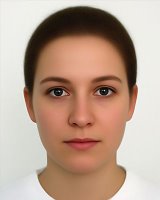
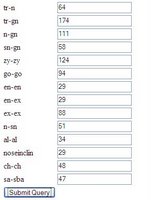

Next, I will perform a similar analysis on the prototypical attractive faces as listed in the above cited page.
UPDATE: The results for the attractive German female are below. She has a score of German=97, and is thus more "distinguishable" as German than her average counterpart, pictured above. Perhaps this provides some limited evidence that the population may value a national archetype above the current population average.
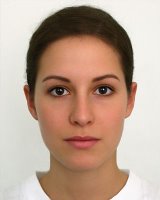
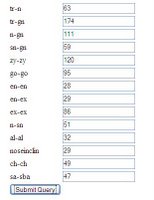

UPDATE: Here are the results for the attractive German who gets a score of German=75, again higher than his average counterpart (listed above). This is working better than I had anticipated.



Next update: the prototypical unattractive German male and female.
UPDATE: This is getting ever more interesting. The prototypical unattractive German male has a German score=2, and has Croatian=58 and Greek=32 as its closest matches. Our expectation that Germans find German-looking faces to be attractive and non-German-looking ones to be unattractive seems to be confirmed so far!
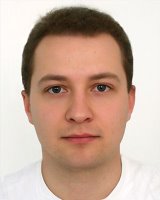


Now for the prototypical unattractive female German face, which turns out to be closest to Italian=71. Doesn't look very Italian to me, or I'm getting tired, but who knows?
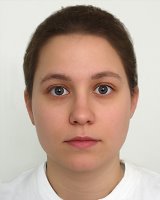


That's it for today, but if you have any sources of good pictures or any other ethnic averages, leave a comment. Also, if you want to test your own subjects, and you don't know what is the correspondence between pixels and mm, then you can use the assumption of male tr-gn = 182.4mm and female tr-gn = 172.6mm; or look up the original paper and substitute a population-appropriate value.
UPDATE: I used anthropometric data for Korean American women. The jaw width was unknown, so I substituted the median value of 99.2mm. As expected, the most probable populations were Singaporean Chinese and Japanese, two of the Mongoloid populations included in the calculator.

UPDATE: This is just too good! Surprised with the result of the unattractive German female, I decided to test an attractive Italian female and see how she measured up. This was the best frontal picture of Monica Bellucci that I could find. Here are her results. I used the median value of nose inclination.



UPDATE: Phidias' Apollo. Median values for ear height and nose inclination. Results follow:

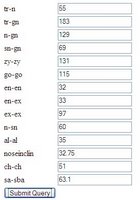

UPDATE: Praxiteles' Aphrodite of Knidos. Median value for nose inclination and ear length.


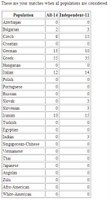
I recommend that you use a photographic method to obtain the 14 necessary measurements. You should take good pictures of your face and profile and determine the correspondence between the number of pixels and millimeters. For example, if the width of your jaw (go-go) is 110mm and is 200 in pixels, then you know that if a horizontal feature is X pixels wide then it is in reality 110X/200 mm wide. I suggest that you try different features, both vertical and horizontal until you are convinced of the good correspondence. Then you can calculate the measurements from your photograph that are too difficult to get directly from your face without specialized instruments. Another good idea is to photograph a ruler or piece of paper of known dimensions precisely at the distance where you will be taking the picture.
Make sure that the picture is not taken at very short range, because this will lead to a distortion of your features. Also, make sure that you are facing foreward and your head is in the horizontal plane. Roughly speaking, your ear hole and the bottom of your eye socket should be horizontal. Try to emulate the drawings as best as you can, and don't forget to keep your mouth closed and natural.
The only measurement that is not explained in the visual guide is nose inclination. This is the angle formed between the spine of your nose and the horizontal line in degrees. You can calculate this using trigonometry. Leave a comment if you are mathematically challenged, and someone might help you if you phrase your question right.
Feel free to leave a comment if you use the calculator. As with the other calculators from the Anthropological Research Page, your results will be meaningless if you don't take extra good care in your measurements.
UPDATE: The female version can be found here.
UPDATE: I have to say that I am surprised with my results. I was not at all satisfied with the way my measurements turned out, so I did them twice. Either the calculator really works well, or it got a lucky guess. Do your own and let me know how it works for you!


UPDATE (Sep 8): The male and female versions are now online with some improvements to help users detect possible problem areas in their measurements.
UPDATE: To validate the calculator, I carried out a small experiment, using the modern Greek average that I had previously created, as well as average Germans that I had previously blogged about.
Using these pictures presented some problems. First of all, the nose inclination could not be estimated from a face picture, so I substituted the population value from the original data. Second, the scale of the pictures could not be determined, so I followed the following procedure: first, I determined which of the 14 measurements had the smallest variability in different populations by dividing the standard deviation (over all populations) / average value (over all populations). It turned out that physiognomical height (trichion-gnathion) had a ratio of about 0.03. So, I based my conversion on this measurement, filling in the unknown physiognomical height with the median (over all populations).
The results seem fairly satisfactory. I list below the input values (as calculated per the above procedure) as well as the results of the anthropometric analysis. In both German sexes, the value I calculated from the pictures was lower than the measured German average; this is probably because Germans have less of the hanging earlobe type and it is thus not easy to observe the true low point of the auricle from a facial view.
Greek male



German male



German female



Next, I will perform a similar analysis on the prototypical attractive faces as listed in the above cited page.
UPDATE: The results for the attractive German female are below. She has a score of German=97, and is thus more "distinguishable" as German than her average counterpart, pictured above. Perhaps this provides some limited evidence that the population may value a national archetype above the current population average.



UPDATE: Here are the results for the attractive German who gets a score of German=75, again higher than his average counterpart (listed above). This is working better than I had anticipated.



Next update: the prototypical unattractive German male and female.
UPDATE: This is getting ever more interesting. The prototypical unattractive German male has a German score=2, and has Croatian=58 and Greek=32 as its closest matches. Our expectation that Germans find German-looking faces to be attractive and non-German-looking ones to be unattractive seems to be confirmed so far!



Now for the prototypical unattractive female German face, which turns out to be closest to Italian=71. Doesn't look very Italian to me, or I'm getting tired, but who knows?



That's it for today, but if you have any sources of good pictures or any other ethnic averages, leave a comment. Also, if you want to test your own subjects, and you don't know what is the correspondence between pixels and mm, then you can use the assumption of male tr-gn = 182.4mm and female tr-gn = 172.6mm; or look up the original paper and substitute a population-appropriate value.
UPDATE: I used anthropometric data for Korean American women. The jaw width was unknown, so I substituted the median value of 99.2mm. As expected, the most probable populations were Singaporean Chinese and Japanese, two of the Mongoloid populations included in the calculator.

UPDATE: This is just too good! Surprised with the result of the unattractive German female, I decided to test an attractive Italian female and see how she measured up. This was the best frontal picture of Monica Bellucci that I could find. Here are her results. I used the median value of nose inclination.



UPDATE: Phidias' Apollo. Median values for ear height and nose inclination. Results follow:



UPDATE: Praxiteles' Aphrodite of Knidos. Median value for nose inclination and ear length.



September 07, 2006
DNA is preserved in ancient parchments
Journal of Archaeological Science (Article in Press)
Ancient DNA and the genetic signature of ancient Greek manuscripts
N. Poulakakis, A. Tselikas, I. Bitsakis, M. Mylonas, and P. Lymberakis
Abstract
Determination of the species origin of historic objects is one of the common tasks of ancient DNA (aDNA) analysis. DNA recovered from archaeological and palaeontological remains allows going back in time and revealing the genetic signature of several human tools. Comparisons of this signature with DNA sequence from recent animals (wild and domestic goats) from several Mediterranean regions are expected to allow us to identify a geographical origin for the biological material used to produce the Greek parchment manuscripts. Here, we have realised an experiment based on which it is possible to recover DNA from ancient parchment fragments (three Greek parchment manuscripts of relatively recent age: 13th to 16th century AD). The analysis of the three Greek manuscripts has shown that most signature documents have goat-related sequences (Capra spp.). As demonstrated, DNA of animals whose skins furnished the parchment pages of ancient and medieval books may survive in that parchment, enabling not only to determine the species of the animal from which the skin had been taken, but moreover, it might even be possible to reconstitute the history of the herds from which they originated.
Link
Ancient DNA and the genetic signature of ancient Greek manuscripts
N. Poulakakis, A. Tselikas, I. Bitsakis, M. Mylonas, and P. Lymberakis
Abstract
Determination of the species origin of historic objects is one of the common tasks of ancient DNA (aDNA) analysis. DNA recovered from archaeological and palaeontological remains allows going back in time and revealing the genetic signature of several human tools. Comparisons of this signature with DNA sequence from recent animals (wild and domestic goats) from several Mediterranean regions are expected to allow us to identify a geographical origin for the biological material used to produce the Greek parchment manuscripts. Here, we have realised an experiment based on which it is possible to recover DNA from ancient parchment fragments (three Greek parchment manuscripts of relatively recent age: 13th to 16th century AD). The analysis of the three Greek manuscripts has shown that most signature documents have goat-related sequences (Capra spp.). As demonstrated, DNA of animals whose skins furnished the parchment pages of ancient and medieval books may survive in that parchment, enabling not only to determine the species of the animal from which the skin had been taken, but moreover, it might even be possible to reconstitute the history of the herds from which they originated.
Link
Y chromosomes reveal limited Viking settlement in Ireland
More on this later...
European Journal of Human Genetics (advance online publication)
The scale and nature of Viking settlement in Ireland from Y-chromosome admixture analysis
Brian McEvoy et al.
Abstract
The Vikings (or Norse) played a prominent role in Irish history but, despite this, their genetic legacy in Ireland, which may provide insights into the nature and scale of their immigration, is largely unexplored. Irish surnames, some of which are thought to have Norse roots, are paternally inherited in a similar manner to Y-chromosomes. The correspondence of Scandinavian patrilineal ancestry in a cohort of Irish men bearing surnames of putative Norse origin was examined using both slow mutating unique event polymorphisms and relatively rapidly changing short tandem repeat Y-chromosome markers. Irish and Scandinavian admixture proportions were explored for both systems using six different admixture estimators, allowing a parallel investigation of the impact of method and marker type in Y-chromosome admixture analysis. Admixture proportion estimates in the putative Norse surname group were highly consistent and detected little trace of Scandinavian ancestry. In addition, there is scant evidence of Scandinavian Y-chromosome introgression in a general Irish population sample. Although conclusions are largely dependent on the accurate identification of Norse surnames, the findings are consistent with a relatively small number of Norse settlers (and descendents) migrating to Ireland during the Viking period (ca. AD 800–1200) suggesting that Norse colonial settlements might have been largely composed of indigenous Irish. This observation adds to previous genetic studies that point to a flexible Viking settlement approach across North Atlantic Europe.
Link
European Journal of Human Genetics (advance online publication)
The scale and nature of Viking settlement in Ireland from Y-chromosome admixture analysis
Brian McEvoy et al.
Abstract
The Vikings (or Norse) played a prominent role in Irish history but, despite this, their genetic legacy in Ireland, which may provide insights into the nature and scale of their immigration, is largely unexplored. Irish surnames, some of which are thought to have Norse roots, are paternally inherited in a similar manner to Y-chromosomes. The correspondence of Scandinavian patrilineal ancestry in a cohort of Irish men bearing surnames of putative Norse origin was examined using both slow mutating unique event polymorphisms and relatively rapidly changing short tandem repeat Y-chromosome markers. Irish and Scandinavian admixture proportions were explored for both systems using six different admixture estimators, allowing a parallel investigation of the impact of method and marker type in Y-chromosome admixture analysis. Admixture proportion estimates in the putative Norse surname group were highly consistent and detected little trace of Scandinavian ancestry. In addition, there is scant evidence of Scandinavian Y-chromosome introgression in a general Irish population sample. Although conclusions are largely dependent on the accurate identification of Norse surnames, the findings are consistent with a relatively small number of Norse settlers (and descendents) migrating to Ireland during the Viking period (ca. AD 800–1200) suggesting that Norse colonial settlements might have been largely composed of indigenous Irish. This observation adds to previous genetic studies that point to a flexible Viking settlement approach across North Atlantic Europe.
Link
September 06, 2006
Britain's human history of migration, extinction, migration, ...
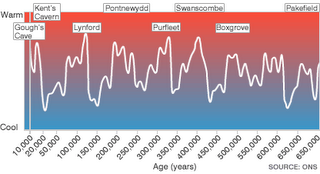
The BBC has an article describing research by Chris Stringer and others on the human occupation of Britain.
Scientists now think there were seven gaps in the occupation story - times when there was probably no human settlement of any kind on these shores. Britain and the British people of today are essentially new arrivals - products only of the last influx 12,000 years.
"Australian aboriginals have been in Australia longer, continuously than the British people have been in Britain. There were probably people in the Americas before 12,000 years ago," Professor Stringer explained.
People probably managed to establish permanent presence in Australia and the Americas because these were attractive, resource-rich areas for human occupation. Britain, on the other hand, was unsuitable for humans, and was colonized in an opportunistic manner whenever climatic conditions allowed it. The foundation and abandonment of the Norse settlements in Greenland and the Americas should probably be thought of as historical analogues to the multiple failed attempt to colonize Britain.
Shared Y-chromosome heritage of Hindus and Muslims in India
A new study has looked at the Y-chromosome variation of a sample of Hindus and Muslims from Andhra Pradesh, finding them to be similar to each other. This indicates that at least in this case, the transmission of the Muslim religion was largely non-genetic.
Human Genetics (online early)
A shared Y-chromosomal heritage between Muslims and Hindus in India
Ramana Gutala et al.
Abstract Arab forces conquered the Indus Delta region in 711 AD and, although a Muslim state was established there, their influence was barely felt in the rest of South Asia at that time. By the end of the tenth century, Central Asian Muslims moved into India from the northwest and expanded throughout the subcontinent. Muslim communities are now the largest minority religion in India, comprising more than 138 million people in a predominantly Hindu population of over one billion. It is unclear whether the Muslim expansion in India was a purely cultural phenomenon or had a genetic impact on the local population. To address this question from a male perspective, we typed eight microsatellite loci and 16 binary markers from the Y chromosome in 246 Muslims from Andhra Pradesh, and compared them to published data on 4,204 males from East Asia, Central Asia, other parts of India, Sri Lanka, Pakistan, Iran, the Middle East, Turkey, Egypt and Morocco. We find that the Muslim populations in general are genetically closer to their non-Muslim geographical neighbors than to other Muslims in India, and that there is a highly significant correlation between genetics and geography (but not religion). Our findings indicate that, despite the documented practice of marriage between Muslim men and Hindu women, Islamization in India did not involve large-scale replacement of Hindu Y chromosomes. The Muslim expansion in India was predominantly a cultural change and was not accompanied by significant gene flow, as seen in other places, such as China and Central Asia.
Link
Human Genetics (online early)
A shared Y-chromosomal heritage between Muslims and Hindus in India
Ramana Gutala et al.
Abstract Arab forces conquered the Indus Delta region in 711 AD and, although a Muslim state was established there, their influence was barely felt in the rest of South Asia at that time. By the end of the tenth century, Central Asian Muslims moved into India from the northwest and expanded throughout the subcontinent. Muslim communities are now the largest minority religion in India, comprising more than 138 million people in a predominantly Hindu population of over one billion. It is unclear whether the Muslim expansion in India was a purely cultural phenomenon or had a genetic impact on the local population. To address this question from a male perspective, we typed eight microsatellite loci and 16 binary markers from the Y chromosome in 246 Muslims from Andhra Pradesh, and compared them to published data on 4,204 males from East Asia, Central Asia, other parts of India, Sri Lanka, Pakistan, Iran, the Middle East, Turkey, Egypt and Morocco. We find that the Muslim populations in general are genetically closer to their non-Muslim geographical neighbors than to other Muslims in India, and that there is a highly significant correlation between genetics and geography (but not religion). Our findings indicate that, despite the documented practice of marriage between Muslim men and Hindu women, Islamization in India did not involve large-scale replacement of Hindu Y chromosomes. The Muslim expansion in India was predominantly a cultural change and was not accompanied by significant gene flow, as seen in other places, such as China and Central Asia.
Link
September 05, 2006
More on designer babies
EurekAlert has an announcement about some new research revealing different attitudes of people towards manipulations of one's offspring.
The results of a series of surveys of 100-200 participants included:
- The better educated prospective parents are, the further they are prepared to go to improve their children's IQ.
- Women interpret certain interventions in child rearing as "design acts" more readily than men.
- People over 50 interpret certain interventions as "design acts" more readily than people under 25.
- Because of "parental uncertainty" - the idea than women know for certain if a child is their's whereas men do not – men show a significantly greater preference than female parents for their children to inherit their own characteristics.
- Parents see different physical, social and intellectual characteristics as desirable depending on the sex of the child.
- Older women and childless women are significantly more willing to "improve" the physical, social and intellectual characteristics of prospective children? (This can be explained by women seeking to increase their genetic heredity, particularly when their time to reproduce begins to decrease.)
- Both men and women see genetic engineering as acceptable primarily for medical applications.
September 04, 2006
Genetic screening of embryos and the changing course of Human evolution
In the past, man could control evolution only by choosing a mate and deciding how many children to have. With genetic screening of embryos, he can now remove some of the random element of recombination, in essence, choosing which of his genes to pass on to his offspring.
Couples Cull Embryos to Halt Heritage of Cancer
The next step is to modify genes themselves, i.e., to bear children that have gene variants that neither parent possesses. If this does occur, then our evolution will increasingly be driven not by the demographics of childbirth, but by our social ideals.
Will parents continue to bear children the old-fashioned way, when their neighbors are making sure that their children are as disease-free as possible, and as close to social ideals of perfection as technology allows? Or, will all babies, at least in affluent societies be born through the test tube?
And, what happens to ideas of kinship, once your children do not possess 50% of your genes, but x% of your genes and (50-x)% of genes picked from a catalogue?
Perhaps, the next stage of evolution will not be driven by selfish genes manipulating human bodies to perpetuate themselves, but by symbiotic meme-gene complexes, where memes manipulate brains to select genes for one's offspring, and genes create brains conducive to such manipulation.
But, will our drive to create perfect offspring, perhaps eliminate that little bit of weirdness which is responsible for all high human creativity?
Couples Cull Embryos to Halt Heritage of Cancer
By subjecting Chloe to a genetic test when she was an eight-cell embryo in a petri dish, Mr. Kingsbury and his wife, Colby, were able to determine that she did not harbor the defective gene. That was the reason they selected her, from among the other embryos they had conceived through elective in vitro fertilization, to implant in her mother’s uterus.
Prospective parents have been using the procedure, known as preimplantation genetic diagnosis, or P.G.D., for more than a decade to screen for genes certain to cause childhood diseases that are severe and largely untreatable.
Now a growing number of couples like the Kingsburys are crossing a new threshold for parental intervention in the genetic makeup of their offspring: They are using P.G.D. to detect a predisposition to cancers that may or may not develop later in life, and are often treatable if they do.
The next step is to modify genes themselves, i.e., to bear children that have gene variants that neither parent possesses. If this does occur, then our evolution will increasingly be driven not by the demographics of childbirth, but by our social ideals.
Will parents continue to bear children the old-fashioned way, when their neighbors are making sure that their children are as disease-free as possible, and as close to social ideals of perfection as technology allows? Or, will all babies, at least in affluent societies be born through the test tube?
And, what happens to ideas of kinship, once your children do not possess 50% of your genes, but x% of your genes and (50-x)% of genes picked from a catalogue?
Perhaps, the next stage of evolution will not be driven by selfish genes manipulating human bodies to perpetuate themselves, but by symbiotic meme-gene complexes, where memes manipulate brains to select genes for one's offspring, and genes create brains conducive to such manipulation.
But, will our drive to create perfect offspring, perhaps eliminate that little bit of weirdness which is responsible for all high human creativity?
September 02, 2006
15 minute test reduces racial achievement gap by 40%
From the accompanying story in Science:
From the EurekAlert public release:
See also White-black IQ gap has shrunk in the United States.
Science Vol. 313. no. 5791, pp. 1307 - 1310
Reducing the Racial Achievement Gap: A Social-Psychological Intervention
Geoffrey L. Cohen, Julio Garcia, Nancy Apfel, Allison Master
Two randomized field experiments tested a social-psychological intervention designed to improve minority student performance and increase our understanding of how psychological threat mediates performance in chronically evaluative real-world environments. We expected that the risk of confirming a negative stereotype aimed at one's group could undermine academic performance in minority students by elevating their level of psychological threat. We tested whether such psychological threat could be lessened by having students reaffirm their sense of personal adequacy or "self-integrity." The intervention, a brief in-class writing assignment, significantly improved the grades of African American students and reduced the racial achievement gap by 40%. These results suggest that the racial achievement gap, a major social concern in the United States, could be ameliorated by the use of timely and targeted social-psychological interventions.
Link
Some readers will undoubtedly be surprised, or even incredulous, that a 15-min intervention can reduce the racial achievement gap by 40%. Yet this is precisely what Cohen et al. (1) report on page 1307 of this issue. African American seventh graders randomly assigned to write about their most important values achieved significantly better end-of-semester grades than students in a control condition. How can this be?
...
In each study, people in the treatment conditions achieved better grades than people in the control conditions. These increases were modest, averaging .29 on a grade-point average (GPA) scale (where A = 4, B = 3, and so on; see the table). Nonetheless, these gains are impressive, given that grades were assessed from several weeks to several months after the interventions.
From the EurekAlert public release:
The African-American students who completed the in-class assignment improved their end-of-term grades by three-tenths of a grade point, closing the gap by 40 percent, according to Cohen. The assignment had no impact on white students' grades. While the study results are encouraging, Cohen said he isn't suggesting the findings to be a "silver bullet."
"We don't really know how these results will transfer to other schools and areas in the country, or know conclusively what the psychological mechanism behind this is," Cohen said. "However, it may turn out that if we intervene earlier, the gap could be reduced even more."
As an example of how chronic stress affects performance, Cohen used a workplace analogy where two good friends work together and one of them tells the other that the boss may not like him.
"While both employees may feel workplace stress, the one who thinks the boss may not like him is going to feel a higher level of stress," Cohen said. "He may ask himself, 'Is this constructive criticism from the boss or is the boss biased against me?' Over time, the chronic stress of this social situation would probably negatively affect his job performance," he said.
See also White-black IQ gap has shrunk in the United States.
Science Vol. 313. no. 5791, pp. 1307 - 1310
Reducing the Racial Achievement Gap: A Social-Psychological Intervention
Geoffrey L. Cohen, Julio Garcia, Nancy Apfel, Allison Master
Two randomized field experiments tested a social-psychological intervention designed to improve minority student performance and increase our understanding of how psychological threat mediates performance in chronically evaluative real-world environments. We expected that the risk of confirming a negative stereotype aimed at one's group could undermine academic performance in minority students by elevating their level of psychological threat. We tested whether such psychological threat could be lessened by having students reaffirm their sense of personal adequacy or "self-integrity." The intervention, a brief in-class writing assignment, significantly improved the grades of African American students and reduced the racial achievement gap by 40%. These results suggest that the racial achievement gap, a major social concern in the United States, could be ameliorated by the use of timely and targeted social-psychological interventions.
Link
September 01, 2006
Why we need more anthropometry
Kerim of Savage Minds, an anthropological blog, writes a post titled Anthropometry: Alive and Kicking. In it, he dismisses the 1988 All India Anthropometric Survey, North Zone : Basic Anthropometric Data, although it is not at all clear why he objects to anthropometry. I guess, anthropometry is what those bad old colonial racists did, so dismissing it requires no justification.
Anthropometry is the measurement of the human body: its shape, size, color; the collection of quantitative data about human beings. Anthropology is the study of mankind. Without anthropometric data there is no anthropology, or at most there is something like modern social or cultural "anthropology", a data-lite, theory-heavy field which generates papers with titles like "Coetzee, Agamben, and the Passion of Abu Ghraib", "The End of the Soul: Scientific Modernity, Atheism, and Anthropology in France", "Piro Designs: Painting as Meaningful Action in an Amazonian Lived World", "Agency, Personhood and the 'I' of Discourse in the Pacific and Beyond"
It is often erroneously claimed that modern science has superseded traditional physical anthropology. The old typologists, it is said, were misguided, their conclusions wrong, their caliper-wielding methods naive, or even dangerous, leading to racism, intolerance, genocide, and assorted very bad things.
On the contrary, many of the conclusions of traditional physical anthropology, such as the taxonomic division of Homo sapiens into at least four subspecies have stood the test of time, having been amply confirmed by genetic studies, as well as the multivariate analysis of craniometric and anthropometric data.
The old physical anthropology was simply limited by its lack of computational power and statistical methodology. Most of it was done before the pioneering work of R. A. Fisher's discriminant functions, before the use of classification trees, clustering algorithms, or Principal Components Analysis. Without computers, multivariate analyses of large samples were unthinkable. Anthropologists relied on their expertise, and on simple comparisons of means and standard deviations of single traits. Nonetheless, at least for the major problems, their conclusions were essentially correct.
Nowadays, computational power is abundant, statistical methodology is well established, and tools for collecting data about human personality, intelligence, genes, and appearance are there for anyone to use. Unfortunately, though, no one is using them. The Human Genome Diversity Program was shot down, and the Genographic Project, privately funded, is a much toned down version, which aims only to reconstruct human origins.
As a practical matter, anthropologists could easily do a comprehensive study of human variation. Imagine a study where 100,000 people from around the world are given a thorough anthropometric measurement, an IQ test, a personality test, a number of medical tests, and a comprehensive genetic test which can be refined down the road as gene sequencing becomes cheaper. Imagine thousands of attributes, phenotypic or genotypic, for each one of the 100,000, the first large sampling of human variation in all its measurable aspects. Such a database wouldn't cost much, but would allow us to really speak authoritatively about human variation.
What is stopping us from doing such a study? Bizarre notions about the rights of indigenous groups, a dogmatic rejection of any correlation between physical (especially racial) traits with morality, personality, or cognitive function, a pre-occupation with medical applications and pathological variation.
We need more anthropometry, not less. More psychometry too, more genetic testing, more data of every kind. Above all, more willingness to study man quantitatively, rather than a reliance on politically-correct preconceptions about ourselves.
Anthropometry is the measurement of the human body: its shape, size, color; the collection of quantitative data about human beings. Anthropology is the study of mankind. Without anthropometric data there is no anthropology, or at most there is something like modern social or cultural "anthropology", a data-lite, theory-heavy field which generates papers with titles like "Coetzee, Agamben, and the Passion of Abu Ghraib", "The End of the Soul: Scientific Modernity, Atheism, and Anthropology in France", "Piro Designs: Painting as Meaningful Action in an Amazonian Lived World", "Agency, Personhood and the 'I' of Discourse in the Pacific and Beyond"
It is often erroneously claimed that modern science has superseded traditional physical anthropology. The old typologists, it is said, were misguided, their conclusions wrong, their caliper-wielding methods naive, or even dangerous, leading to racism, intolerance, genocide, and assorted very bad things.
On the contrary, many of the conclusions of traditional physical anthropology, such as the taxonomic division of Homo sapiens into at least four subspecies have stood the test of time, having been amply confirmed by genetic studies, as well as the multivariate analysis of craniometric and anthropometric data.
The old physical anthropology was simply limited by its lack of computational power and statistical methodology. Most of it was done before the pioneering work of R. A. Fisher's discriminant functions, before the use of classification trees, clustering algorithms, or Principal Components Analysis. Without computers, multivariate analyses of large samples were unthinkable. Anthropologists relied on their expertise, and on simple comparisons of means and standard deviations of single traits. Nonetheless, at least for the major problems, their conclusions were essentially correct.
Nowadays, computational power is abundant, statistical methodology is well established, and tools for collecting data about human personality, intelligence, genes, and appearance are there for anyone to use. Unfortunately, though, no one is using them. The Human Genome Diversity Program was shot down, and the Genographic Project, privately funded, is a much toned down version, which aims only to reconstruct human origins.
As a practical matter, anthropologists could easily do a comprehensive study of human variation. Imagine a study where 100,000 people from around the world are given a thorough anthropometric measurement, an IQ test, a personality test, a number of medical tests, and a comprehensive genetic test which can be refined down the road as gene sequencing becomes cheaper. Imagine thousands of attributes, phenotypic or genotypic, for each one of the 100,000, the first large sampling of human variation in all its measurable aspects. Such a database wouldn't cost much, but would allow us to really speak authoritatively about human variation.
What is stopping us from doing such a study? Bizarre notions about the rights of indigenous groups, a dogmatic rejection of any correlation between physical (especially racial) traits with morality, personality, or cognitive function, a pre-occupation with medical applications and pathological variation.
We need more anthropometry, not less. More psychometry too, more genetic testing, more data of every kind. Above all, more willingness to study man quantitatively, rather than a reliance on politically-correct preconceptions about ourselves.
Greece 101 - USA 95
 Now for the cup.
Now for the cup.Update: Congratulations to Spain for winning the championship. Here is my play-by-play of the game.
Humans have more copies of mystery gene MGC8902 affecting the brain
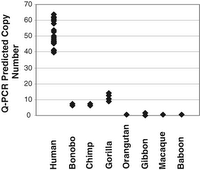 I had written before about the importance of large scale genomic differences in human evolution. Now, a new paper in Science presents clear evidence that a particular gene, MGC8902, which encodes for a protein of unknown function, has the largest number of copies (212) in humans, compared to other primates. A related story in LiveScience. John Hawks comments.
I had written before about the importance of large scale genomic differences in human evolution. Now, a new paper in Science presents clear evidence that a particular gene, MGC8902, which encodes for a protein of unknown function, has the largest number of copies (212) in humans, compared to other primates. A related story in LiveScience. John Hawks comments.Science Vol. 313. no. 5791, pp. 1304 - 1307
Human Lineage–Specific Amplification, Selection, and Neuronal Expression of DUF1220 Domains
Magdalena C. Popesco et al.
Extreme gene duplication is a major source of evolutionary novelty. A genome-wide survey of gene copy number variation among human and great ape lineages revealed that the most striking human lineage–specific amplification was due to an unknown gene, MGC8902, which is predicted to encode multiple copies of a protein domain of unknown function (DUF1220). Sequences encoding these domains are virtually all primate-specific, show signs of positive selection, and are increasingly amplified generally as a function of a species' evolutionary proximity to humans, where the greatest number of copies (212) is found. DUF1220 domains are highly expressed in brain regions associated with higher cognitive function, and in brain show neuron-specific expression preferentially in cell bodies and dendrites.
Link
Subscribe to:
Posts (Atom)






